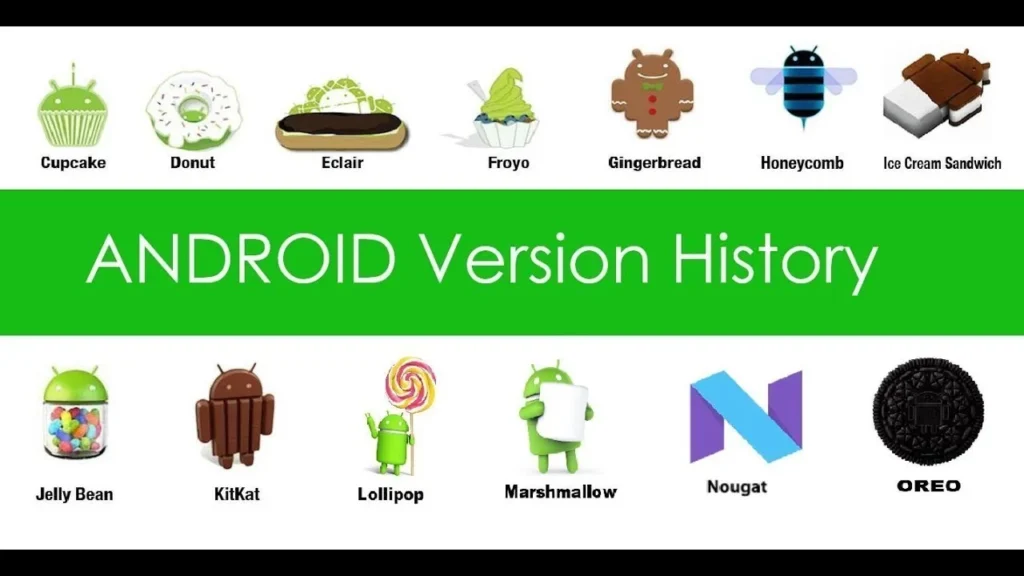Android Versions

Android, Inc. started developing the Android operating system in 2003. Later on, in 2005, Google purchased it. November 5, 2007, featured the release of the Android OS beta version, and November 12, 2007, saw the release of the software development kit (SDK).
In October 2008, the T-Mobile G1 (also known as the HTC Dream) running Android 1.0 became the first Android mobile device to be distributed to the public.
Google declared in August 2019 that it was discontinuing the candy scheme and that going forward, Android versions would be numbered.
Android 10 was the first release of an Android version in numerical order.
Versions, names, and API levels of Android

Code name | Version numbers | API level | Release date |
No codename | 1.0 | 1 | September 23, 2008 |
No codename | 1.1 | 2 | February 9, 2009 |
Cupcake | 1.5 | 3 | April 27, 2009 |
Donut | 1.6 | 4 | September 15, 2009 |
Eclair | 2.0 – 2.1 | 5 – 7 | October 26, 2009 |
Froyo | 2.2 – 2.2.3 | 8 | May 20, 2010 |
Gingerbread | 2.3 – 2.3.7 | 9 – 10 | December 6, 2010 |
Honeycomb | 3.0 – 3.2.6 | 11 – 13 | February 22, 2011 |
Ice Cream Sandwich | 4.0 – 4.0.4 | 14 – 15 | October 18, 2011 |
Jelly Bean | 4.1 – 4.3.1 | 16 – 18 | July 9, 2012 |
KitKat | 4.4 – 4.4.4 | 19 – 20 | October 31, 2013 |
Lollipop | 5.0 – 5.1.1 | 21- 22 | November 12, 2014 |
Marshmallow | 6.0 – 6.0.1 | 23 | October 5, 2015 |
Nougat | 7.0 | 24 | August 22, 2016 |
Nougat | 7.1.0 – 7.1.2 | 25 | October 4, 2016 |
Oreo | 8.0 | 26 | August 21, 2017 |
Oreo | 8.1 | 27 | December 5, 2017 |
Pie | 9.0 | 28 | August 6, 2018 |
Android 10 | 10.0 | 29 | September 3, 2019 |
Android 11 | 11 | 30 | September 8, 2020 |
Android 12 | 12 | 31 | October 4, 2021 |
Android 12L | 12.1 | 32 | March 7, 2022 |
Android 13 | 13 | 33 | August 15, 2022 |
Android 14 | 14 | 34 | October 4, 2023 |
15 | 35 | Q, 2023 |
Android Version 1.0 to 1.1: No codename
September 2008 saw the official release of Android version 1.0. It’s the first Android operating system version. Web browsers can display HTML and XHTML pages, access web email servers (POP3, IMAP4, and SMTP), and view webcams with its support. Google Calendar, Maps, Sync, Search, Talk, Instant Messaging, Media Player, Notifications in the Status Bar, Wallpaper, YouTube Video Player, Alarm Clock, Calculator, Dialer, Pictures (Gallery), Wi-Fi and Bluetooth support are all included in this version.
Version 1.5 of Android: Cupcake
The Android version 1.5 was released on April 27, 2009, and came with the codename “Cupcake” for dessert. The Linux kernel is 2.6.27 on it. It has support for an auto-rotation option, animated screen translations, a third-party virtual keyboard, MPEG-4 video recording and playback, copy and paste functionality, animated screen translations, uploading videos to YouTube, uploading images to Picasa, and checking usage history.
Version 1.6 of Android: Donut
Android 1.6, often known as Donut, was released on September 15, 2009. Many new capabilities are included, including the ability to search text and voice, bookmark history, contacts, the web, “speak” text, faster camera access, text-to-speech engine support, the ability to choose multiple photographs for deletion, and WVGA screen resolutions.
Versions of Android 2.0–2.1: Eclair
Android 2.0, often known as Eclair, was released on October 26, 2009. It was built upon the 2.6.29 Linux kernel. Expanded account sync, Bluetooth 2.1, Microsoft Exchange email support, the option to tap a contact photo and choose to call, SMS, the capacity to search through all saved SMS and MMS messages, the ability to automatically delete the oldest message when the designated limit is reached, minor API, and bug fixes are just a few of the new features.
Froyo, Android versions 2.2 to 2.2.3
Based on the Linux kernel 2.6.32, Android 2.2 (Froyo) was released on May 20, 2010. It has multiple characteristics, including memory, speed, and performance optimization. JIT compilation, the incorporation of Chrome’s V8 engine and JavaScript into the browser program, support for Android Cloud to Device Messaging, compatibility with Adobe Flash, security upgrades, and enhanced performance are all included.
Gingerbread, Android versions 2.3 to 2.3.7
Based on Linux kernel 2.6.35, Android 2.3 (Gingerbread) was released on December 6, 2010. The following updates are included: support for ultra-large screen sizes and resolutions; a new, faster, simpler user interface; improved copy/paste capabilities; the ability to select a word by holding down the keyboard; support for Near Field Communication (NFC); virtualization of headphones; and a new download manager.
Bug fixes for the Nexus S, voice or video chat via Google Talk, network speed for the Nexus S 4G, the Gmail app, battery life, and Google Wallet support for the Nexus S 4G have all been enhanced.
Versions of Android 3.0 to 3.2.6: Honeycomb
Launched on February 22, 2011, Android 3.0 (Honeycomb) was the first Android tablet running on the Linux kernel 2.6.36. Features like a “holographic” tablet user interface, an additional System Bar, easier multitasking by tapping Recent Applications in the System Bar, a redesigned keyboard for speedy typing, quick access to camera exposure, hardware acceleration, support for multi-core processors, improved hardware support, high-performance Wi-Fi lock, Google Books, and fixed data connectivity issues when exiting Airplane mode are just a few of the features it has
Ice Cream Sandwich, versions 4.0 to 4.0.4 of Android
Launched on February 22, 2011, Android 3.0 (Honeycomb) was the first Android tablet running on the Linux kernel 2.6.36. Features like a “holographic” tablet user interface, an additional System Bar, easier multitasking by tapping Recent Applications in the System Bar, a redesigned keyboard for speedy typing, quick access to camera exposure, hardware acceleration, support for multi-core processors, improved hardware support, high-performance Wi-Fi lock, Google Books, and fixed data connectivity issues when exiting Airplane mode are just a few of the features it has
Jelly Bean, Android versions 4.1 to 4.3.1
At the Google I/O conference on June 27, 2012, Google revealed Android 4.1, also known as Jelly Bean. It is built using the 3.0.31 Linux kernel. The following features have been updated: a new clock application, Bluetooth low energy support, volume for incoming calls, support for 4K resolution, native emoji, improved accessibility, expandable notifications, fixed bugs on the Nexus 7, one-finger gestures to expand/collapse notifications, improved lock screen, and support for multiple user accounts (for tablets only).
KitKat, Android 4.4.4 to 4.4.4
Google released the news of Android 4.4 (KitKat) on September 3, 2013. “Key Lime Pie” was its code name at first. On October 31, 2013, Google began rolling out the Nexus 5. Android should have a minimum of 340 MB of RAM accessible to it. The remaining devices are required to identify themselves as “low RAM” devices if their RAM is less than 512 MB. The clock no longer shows strong hours, wireless printing is possible, WebViews based on the Chromium engine, sensor batching, an integrated screen recording tool, improved application compatibility, and a camera application that imports Google+ Photo rather than Gallery are just a few of the new features.
Android Lollipop, versions 5.0 to 5.1.1
Android 5.0 On June 25, 2014, the version of “Lollipop” known as “Android L” was released. Officially, it was unveiled on November 12, 2014. A redesign of the user interface, support for 64-bit CPUs, print previews, material design, Project Volta for longer battery life, multiple user accounts, audio input and output via USB devices, joining Wi-Fi networks, support for multiple SIM cards, device protection, high-definition voice calls, and native Wi-Fi calling support are just a few of the features that Lollipop offers.
Marshmallow, version 6.0 - 6.0.1 of Android

6.0 Android On May 28, 2015, “Marshmallow”—also known as “Android M”—was revealed for the Nexus 5 and Nexus 6 smartphones as well as the Nexus 9 tablet.
Android released “Marshmallow” for all Android devices on October 5, 2015. It has a number of new features, including support for USB-C, native fingerprint reader compatibility, run-time permission requests, the App Standby feature, the introduction of the Doze mode to conserve battery life, and Unicode 7.0 & 8.0 emoji support.
Nougat is the Android version 7.0 to 7.1.2.
Android 7.0 Major Android OS release “Nougat” was the latest version. “Android N” was its codename at first. On March 9, 2016, it was originally made available as a developer preview along with factory images for the Nexus smartphone.
The final preview build was released on August 22, 2016, and included the following features: file-based encryption, screen zoom, support for multiple windows, new Data Saver mode, picture-in-picture functionality, support for support manager APIs, circular app icons, ability to send GIFs straight from the default keyboard, and alerts regarding battery usage. The JIT compiler also made app installation 75% faster.
Oreo is the Android version 8.0 to 8.1.
The eighth major update of the Android operating system was named Android 8.0 “Oreo”. On March 21, 2017, a developer preview was made available. On July 24, 2017, the last developer preview was made available.
Picture-in-picture support, support for Unicode 10.0 emoji (5.0), reorganized settings, adaptive icons, notification channels, notification dots, two times faster boot time, Google Play Protect, integrated printing support, neural network API, shared memory API, Android Oreo Go Edition, autofill framework, automatic light and dark themes, and more were among the features included in its stable version when it was released on August 21, 2017.
Pie, the 9.0 version of Android
The Android operating system saw its ninth major release with the release of Android 9.0 “Pie”. Google originally revealed it and released a preview version on March 7, 2018. Official release took place on August 6, 2018. It now contains a “screenshot” button, the clock has been shifted to the left of the notification bar, and the battery % is always visible.
Version 10 of Android
The tenth major release of the Android operating system is called Android 10. “Android Q” was the codename used when developing Android 10. Google first revealed it on March 13, 2019, and on the same day, the first beta version was made available. The second beta was made available on April 3.
On September 3, 2019, the stable version of Android 10 was made available. It has features like a floating settings panel, support for biometric identification, support for AV1 video codec, new rights to access location in the background, and support for WPA3 Wi-Fi security.
Android 11
The eleventh major release of the Android operating system is the Android 11. Released on September 8, 2020, this is the 18th version of the Android smartphone operating system. With Android 10, the alphabetic naming scheme based on deserts was discontinued. Consequently, the operating system is referred to as “Android 11”.
Features that Android 11 offers
- Discussions: Gather all of your messages in one location.
- Accessibility: Voice instructions enable us to operate and navigate our phone using perceptive apps.
- Device controls: Android 11 gives us centralized control over all of our Internet of Things (IoT) devices.
- Content capture: The screen recording capability of Android 11 records the activity on our phone’s screen at that moment.
- Predictive tools: They make recommendations based on their ability to predict our work habits and tendencies.
- Security & privacy: Android 11 brings further privacy and security updates directly from Google Play to our smartphones.
- Media: We can listen to music on other phones-connected gadgets.











Pingback: Hailee Steinfeld Net Worth Biography, Lifestyle, Wiki, Height